Where on a tidally locked planet with a 25 °C maximum is the 0 °C isotherm?
I am writing a novel. In that novel, humans have settled a tidally locked planet. That planet is positioned at just such a distance from its sun that the sun heats the planet to an average of 25 °C at the substellar point, that is, at the center of the side facing the sun. The planet is like our Earth in size, composition, and atmosphere. As that planet is tidally locked, the permanently dark side is much colder than the side that is in perpetual daylight, perhaps even freezing, with the coldest point on the opposite side of the substellar point.
How far around the planet from the substellar point is the 0 °C isotherm?
Looking at average temperatures on Earth, either for a specific month or the whole year, the distance between a place with 25 °C and a place with 0 °C always seems to be somewhere around 40° to 50° (e.g. from Mexico to Northern Canada in July). So I would suspect the 0 °C isotherm to be about 45° from the substellar point.
This post was sourced from https://worldbuilding.stackexchange.com/q/57924. It is licensed under CC BY-SA 3.0.
1 answer
This is just a basic answer, but I used Samuel et al. (2014), who in turn cited the climate model of Léger et al. (2011) for a tidally-locked planet with no atmosphere. They give the formula for surface temperature as
A very similar derivation of
Now, perhaps we could neglect the greenhouse effect entirely. Yang et al. (2013) write
The greenhouse effect for tidally locked planets is much smaller than those for non-tidally locked planets (Fig.2d). This results from a low-level temperature inversion on the nightside of tidally-locked planets (see also Joshi et al. 1997; Leconte et al. 2013). The inversion is due to efficient radiative cooling by the surface on the nightside and strong atmospheric energy transport from the dayside to the nightside (Merlis & Schneider 2010). The outgoing infrared radiation to space is therefore similar to the near-surface upward infrared radiation, resulting in a small
.
Here,
The 1:1 data points are for a tidally locked planet with clouds; the 2:1 and 6:1 points are for slightly faster rotators and the other two tracks are variations on the tidally locked model. See how the track without clouds has an extremely large greenhouse effect.
Perhaps, then, at most stellar fluxes, we can neglect the greenhouse effect on our tidally locked planet.
Something assumptions I'm still making:
- There is little to no atmospheric circulation.
- The surface is approximately homogeneous.
Take this answer (v1) with a grain of salt. It's only a really, really basic approximation.






















0 comment threads